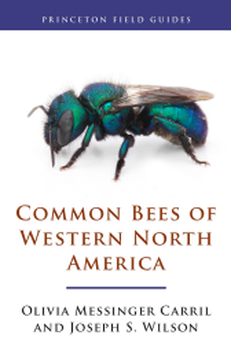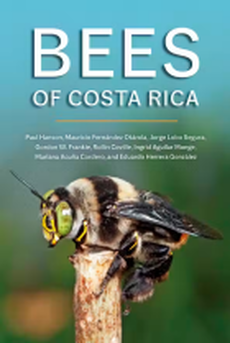|
For those interested in learning more about bee identification, the UC Berkeley Urban Bee Lab has been utilizing the book Common Bees of Western North America published in 2023 by authors Olivia Messinger Carril and Joseph S. Wilson. This book provides an excellent introduction to bee biology and anatomy for individuals of all entomological experience levels, especially beginners, who are hoping to familiarize themselves with the various bee genera of western North America. The images contained in this book are of incredibly high quality, displaying the most important characteristics of bee identification. Two incredibly useful features of this book are the “Quick Reference Guide to Bees of Western North America” which provides readers with a helpful starting point to identify bees based on color and size, along with an actual representative size and shape silhouette found beside each species account throughout the book. Though the description of bee genera is very detailed and inclusive, it is important to note that the authors chose species they found to be most representative of the genera and do not include all of the roughly 1600 species found in California, let alone the more than 3000 species found in western North America. For the non-included species of bees, the authors provide plenty of selected references for the more experienced audience to identify bees at a more advanced level. To aid in general bee identification with a microscope, the highly detailed and simple-to-understand dichotomous key at the back of the book has been a useful step-by-step tool in helping researchers identify bees to genus.
A microscope is not necessary to enjoy the many images in this book and familiarize yourself with the great diversity of bee genera in western North America, but is necessary for putting this book into practice. The level of identification performed at the Urban Bee Lab requires a binocular stereo microscope, which can be purchased relatively inexpensively online at Forestry Suppliers and Ward’s Science. Credit: Jerid Vega <jerid@berkeley.edu> and Gordon Frankie <gwfrankie@berkeley.edu>
0 Comments
In this richly illustrated guide, Bees of Costa Rica, leading bee experts showcase the diversity of bees in Costa Rica and the multitude of ways in which they interact with flowers and people. Thoughtfully compiled and designed for a wide variety of audiences, Bees of Costa Rica is based upon years of biological research of the native bee species of the tropical country. Originally published in Spanish by The Universidad de Costa Rica as Abejas de Costa Rica in 2021, this newly updated 2023 edition has been translated into English and is published through Cornell University Press. With identification keys and more than 150 high-definition color photographs, Bees of Costa Rica is essential for anyone looking to learn about and protect these important pollinators in Costa Rica and beyond. Costa Rica is home to 117 bee genera and approximately 700 bee species. Focusing on the five bee families present in Costa Rica, the authors describe the bees' general physical traits, foraging and mating behavior, and nest characteristics. Chapters cover the relationships between bees and other insects, profiles of plants pollinated by bees, and practical suggestions for bee conservation. Chapters 1, 2, 4, and 5 cover general topics about bees including their importance, biology, behavior, nest associates, and relationships with flowers. Chapter 3 provides detailed profiles of the 5 families of bees found in Costa Rica and includes an informative look at the 51 most common Costa Rican bee genera out of the 117 known within the families. The amazing colored images are invaluable tools to aid the reader in bee identification.
Chapters 6 and 7 present rich information on the plants known to attract bee visitors. Chapter 6 provides an overview of wild and ornamental type plants, while Chapter 7 covers crop plants. There are thousands of plants known to attract the almost 700 bee species recorded in Costa Rica, but the ones selected for the book serve to illustrate the variety of plant types that are well known to have consistent associations with bees. Chapter 8 presents readers with case histories of how human activity has both positively and negatively impacted Costa Rican bee populations. Examples of privately inspired projects to conserve bees and their plants are described, providing inspirational models for others to copy and follow in future endeavors. The authors acknowledge the diverse contributions of numerous Costa Rican and foreign researchers who have published scientific information used in the preparation of this volume. Credit: Cornell University Press, Gordon Frankie (gwfrankie@berkeley.edu), Rollin Coville (rollincoville@gmail.com), Sara Witt (saralwitt@gmail.com), Jerid Vega (jerid@berkeley.edu) |
Details
Archives
December 2023
Categories |


 RSS Feed
RSS Feed
